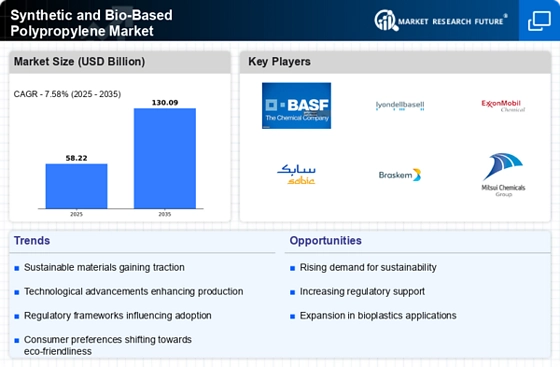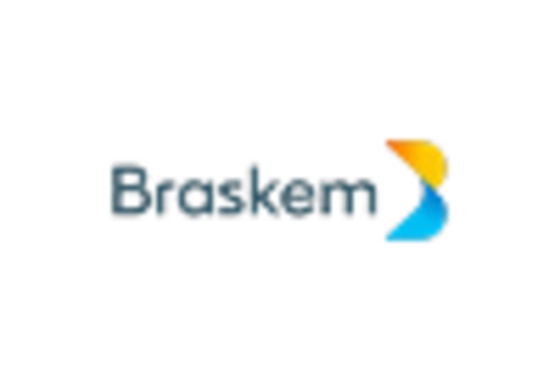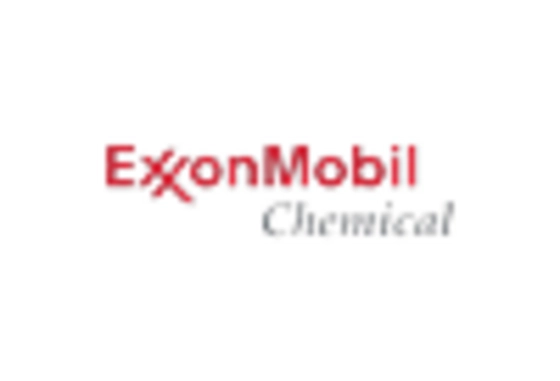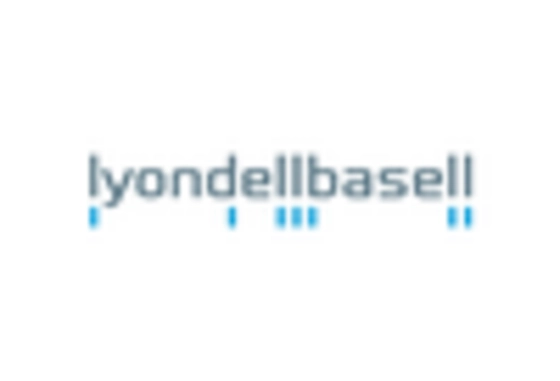Consumer Awareness and Education
Consumer awareness regarding the environmental impact of plastics is a pivotal driver in the Synthetic and Bio-Based Polypropylene Market. As consumers become more educated about the benefits of bio-based materials, their purchasing decisions are increasingly influenced by sustainability considerations. This heightened awareness is leading to a demand for transparency in product sourcing and manufacturing processes. Market data indicates that brands that communicate their sustainability efforts effectively can experience a 25% increase in consumer loyalty. Consequently, manufacturers are focusing on educating consumers about the advantages of bio-based polypropylene, which is perceived as a more responsible choice. This trend is likely to foster a more informed consumer base, further driving the demand for sustainable polypropylene solutions.
Regulatory Incentives and Support
Government regulations and incentives aimed at promoting sustainable materials are significantly influencing the Synthetic and Bio-Based Polypropylene Market. Many countries are implementing policies that encourage the use of bio-based materials through subsidies, tax breaks, and grants. These regulatory frameworks are designed to reduce reliance on fossil fuels and promote environmental sustainability. For example, certain regions have established mandates requiring a percentage of bio-based content in plastic products. This regulatory support is expected to drive the market for bio-based polypropylene, with projections indicating a potential increase in market share by 20% within the next five years. As regulations become more stringent, manufacturers are likely to prioritize the development of bio-based alternatives, further propelling market growth.
Rising Demand for Eco-Friendly Products
The increasing consumer preference for sustainable and eco-friendly products is a primary driver in the Synthetic and Bio-Based Polypropylene Market. As awareness of environmental issues grows, consumers are gravitating towards materials that minimize ecological impact. This trend is reflected in the rising demand for bio-based polypropylene, which is derived from renewable resources. Market data indicates that the bio-based segment is expected to witness a compound annual growth rate (CAGR) of approximately 8% over the next five years. Companies are responding to this demand by investing in the development of innovative, sustainable products, thereby enhancing their market position. The shift towards eco-friendly alternatives is not merely a trend but appears to be a fundamental change in consumer behavior, influencing purchasing decisions across various sectors.
Growing Applications Across Various Industries
The versatility of polypropylene is a significant driver in the Synthetic and Bio-Based Polypropylene Market. Polypropylene is utilized in a wide array of applications, including packaging, automotive, textiles, and consumer goods. The increasing demand for lightweight and durable materials in these sectors is propelling the growth of both synthetic and bio-based polypropylene. For instance, the packaging industry is projected to account for over 30% of the total polypropylene consumption by 2026. Additionally, the automotive sector is increasingly adopting bio-based polypropylene for interior components, driven by the need for sustainable materials. This broad applicability suggests that the market will continue to expand as industries seek to incorporate more sustainable options into their product lines.
Technological Advancements in Production Processes
Technological innovations play a crucial role in shaping the Synthetic and Bio-Based Polypropylene Market. Advances in production techniques, such as catalytic processes and biotechnological methods, are enhancing the efficiency and sustainability of polypropylene manufacturing. These innovations not only reduce production costs but also lower the carbon footprint associated with traditional polypropylene production. For instance, the introduction of advanced catalysts has improved yield rates and reduced energy consumption. Market analysis suggests that these technological advancements could lead to a 15% reduction in production costs over the next few years, making bio-based polypropylene more competitive against conventional options. As manufacturers adopt these technologies, the market is likely to experience a shift towards more sustainable practices, aligning with consumer expectations.


















Leave a Comment